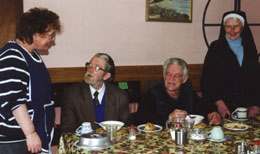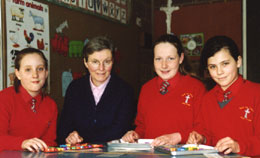History
In pre-famine times, Charleville, like so many towns in Ireland had a very large population, but there was great poverty among the people. Some of the more prosperous wished to improve the situation and among them was Mary Clancy. The parish priest, Fr. Thomas Clarke, supported her. One of the ways of improving life in the area was to bring a religious order to the town. The Bishop of the Diocese of Cloyne, Dr. Crotty, made a formal request of Catherine McAuley to send some of her Sisters. She agreed to establish a foundation in Charleville.
On 29th October, 1836 Catherine McAuley arrived in Charleville with Srs. Angela Dunne, Joseph Delaney and Elizabeth Hynes. Mary Clancy provided a house for them on Clancy Terrace and an initial contribution of £500. The house proved very damp and Angela Dunne, fearing for the health of the Sisters, asked Catherine McAuley to close the foundation. However one day while the Sisters visited the very poor in the lane ways a woman stood at her door and said that it was “God himself that drove ye in among us”. This convinced Catherine of the need for the Sisters to remain in Charleville.
About a year later, the foundation stone of a new convent was laid and the convent itself was opened in 1839. Catherine McAuley wrote: “Charleville has hitherto been a sick branch, but it will be a strong one yet.”
 Magdalen Flynn and her helpers provide meals for a number of men in the town each day. A meals-on-wheels system is also in operation
Magdalen Flynn and her helpers provide meals for a number of men in the town each day. A meals-on-wheels system is also in operation
The Sisters got involved in education, and gave religious instruction in a local national school. They gradually began to teach full-time. The main stress in those days was on teaching what was known as the “three RS” – reading, writing, and arithmetic. Other subjects such as geography, English grammar, lace making, crochet and religious education were also taught. Newer subjects such as hygiene, history and nature study were introduced in the 1850’s, but the earliest reference to the teaching of Irish is not until the 1920’s.
Soon after the Sisters arrived the Fever Hospital in the town was closed and Lord Cork granted it to them, which they used as an Industrial and Infant School. A secondary school began in a room in the convent in 1839. With the purchase of more land thirty years later a new school was built and opened in April 1894.
Visits were made to the sick and the poor in their homes, while others came to the convent for help. In the 1960’s the Sisters did voluntary nursing in the homes. Today Sisters continue to be involved in education, health care and parish work.
Cork City
Catherine McAuley along with five companions – Mary Clare Moore, Josephine Ward, Vincent Deasy, Teresa White and Anastasia McGawley – arrived in Cork City on the steamer “Hercules” on 6th July, 1837. They were escorted to Rutland Street by a Fr. O’Connor, where they were to live and work for the next fifteen years. Once a fashionable quarter, Rutland Street in 1837, had little of its former elegance. The house itself was a gloomy, sombre building, very much in keeping with convents of the time. However, the Sisters began immediately to visit the poor of the parish and soon they became known as the “sick poor order”. They also began a Pension School in a large room in the house in 1838.
As the number of women joining the order increased, it became necessary to build a bigger convent. On 2nd December, 1850, Bishop William Delaney laid the foundation stone of the new convent in Fitton Street, now Sharman Crawford Street. Named “St. Maries of the Isle” the building is located close to the site of an ancient Dominican Priory. A generous contribution was made by a Ms. Barbara Gould towards the building and the plans included a House of Mercy, a National School and an Orphanage. Gothic in style, the new convent was described as “one of the most beautiful ornaments of the ancient city of Cork”.
 Mary O’Mahony with some of the kids in the primary school early start programme in Mayfield, Cork City
Mary O’Mahony with some of the kids in the primary school early start programme in Mayfield, Cork City
The Sisters moved to their new home on 2nd October, 1852. The Pension School was named St. Aloysius School, and this in turn became the first secondary school for girls in the city. The earliest extant register for this school is dated 1887. In 1853 an Infant School and an Industrial School were opened. Later with the acquisition of more land, adjacent to the convent, St. Joseph’s National School was built.
Over time branch houses were opened and today Sisters are engaged in a different ministries in the city.
Killarney
In 1843, two years after the death of Catherine McAuley, Dr. Egan, the Bishop of Kerry, requested Mother Elizabeth Moore, of Limerick, to send Sisters to Killarney. As in so many other places, he was concerned for the plight of the poor, the sick and those without education. There was also help being offered by a wealthy couple in the town, a Mr and Mrs Gallwey.
On 2nd October, 1844 five Sisters arrived in Killarney and stayed in a house provided for them by the Gallwey’s, at St. Brigid’s, High Street. From the moment of their arrival the Sisters began caring for those who were sick and housebound. With the aid of donations from various well off people in the area, the Sisters were able to relieve distress and to distribute hot meals at the convent several times a week.
During the famine years the Sisters nursed the sick and dying in their homes, in the temporary wards set up in the then unfinished Cathedral building, and in Brewery Lane where people lay on nothing but straw. The famine also took its toll on the Sisters with twenty of them dying between 1850 and 1853.
After the famine the Bishop encouraged the Sisters to get involved in education. By 1854 they had started a school – St. David’s – at what is now the site of the Arbutus Hotel. As the number of Sisters increased, the Earl of Kenmare gave an attractive site on Rock Road, where Holy Cross Convent and schools were built. The Sisters moved there on 2nd July, 1857. St. Joseph’s Orphanage was opened in 1861. A lace industry and a laundry were also started to provide employment for girls. In response to a request from the Poor Law Guardians six Sisters were assigned to a convent attached to the workhouse and began a nursing ministry in the town.
The Sisters continue to work in education, healthcare and parish ministry today.
 Colette Dennehy works as a learning support teacher in Holy Cross Primary School, Killarney.
Colette Dennehy works as a learning support teacher in Holy Cross Primary School, Killarney.
Pictured here with Louise, Linda and Yasmin


